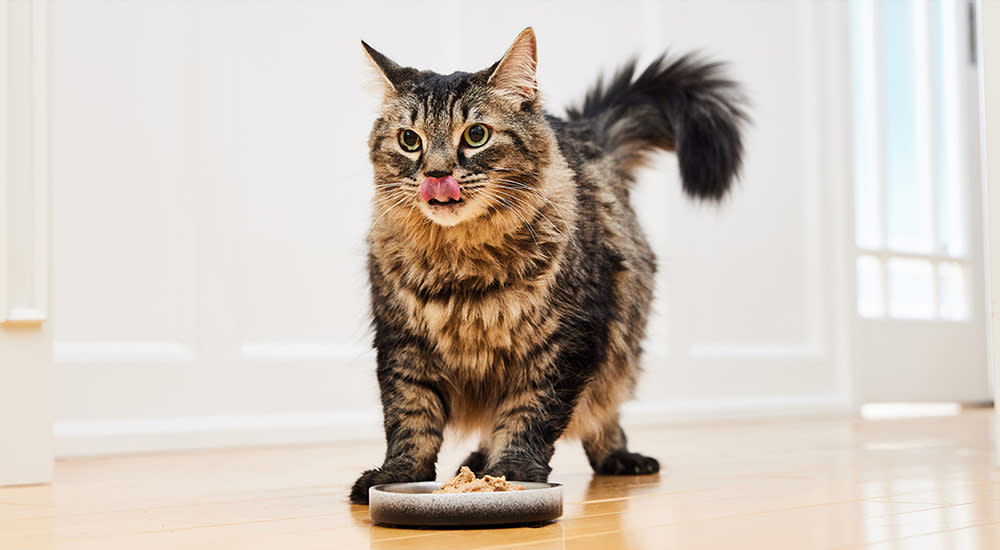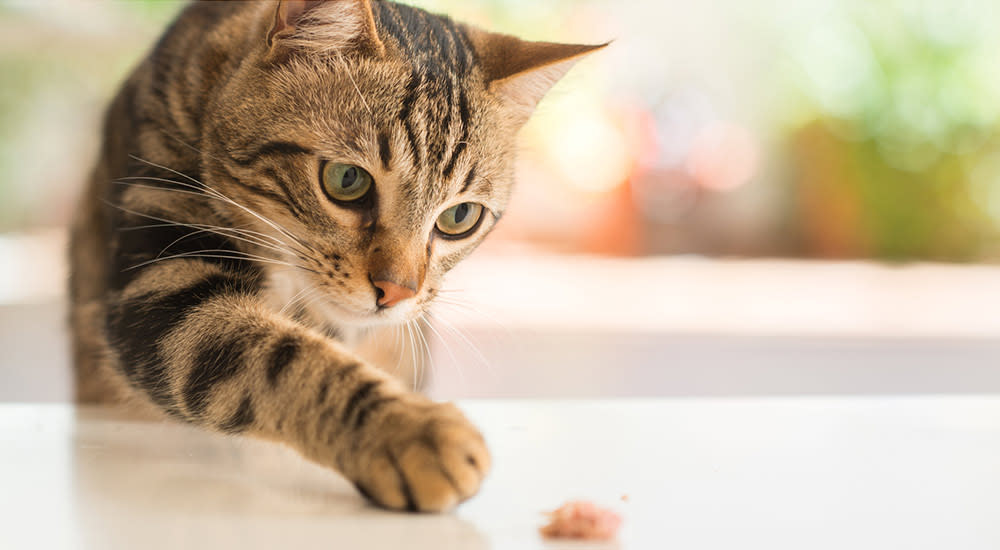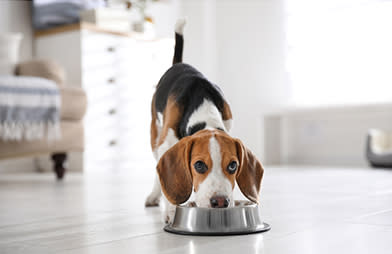From kibble to canned food and everything in between, pet food can be a mystery — even for long-time pet parents. What ingredients go into pet food and why? What type of food is best for our pets? How do we know if what we’re feeding our cat or dog has everything they need in terms of vitamins, minerals, and calories?
When it comes to choosing a pet food, there are a LOT of questions to ask. Not only do pets require different foods at different stages of life, some may need food that helps to control weight or keep allergies at bay.
If you have questions about your pet’s diet (what to feed, how much to feed, and how often) your vet is a great resource, as are the staff at your local pet store.
To delve into the science and philosophy behind what we feed our pets, we asked animal nutritionist Kylie Hogan about her work formulating Performatrin brand pet foods.
The philosophy of feeding
Many pet parents have strong feelings and opinions about what they feed their animals — which is understandable considering pet’s are another valued member of the family.
But whether you choose kibble, canned food, or commercially available raw diets, high-quality pet food is formulated to be nutritionally complete for your pet. The people who develop quality pet foods formulate them to meet the highest quality, safety, and nutrition standards.
When choosing a pet food, your decision will likely be based on your preference and your pet’s palate and dietary needs (think: age, activity level, or food intolerance). Beyond those factors, there are specific feeding philosophies you might want to consider.
What your pet needs from their food
Over the course of their life with you, your pet will require different things from their diet. So the first thing you’ll encounter when deciding on a diet is the life stage of your animal.
Puppies and kittens have specific needs. The same goes for senior pets.
Hogan says animals in their first year of life are still growing and need food that has “more of basically everything.” More fat, more protein, more minerals, and more vitamins. And while “more” might sound better, it isn’t for older animals.
“Once you reach that adult stage, you don't need as much. You're in a maintenance stage of life.” Hogan says adult diet formulations include lower levels of fat, vitamins, and minerals because the pet is fully grown.
“Adult dogs can still eat puppy foods and not have any health concerns. But usually we save that for a more active pet like a working dog or someone who has a very active lifestyle. Then they'd need extra nutrients in their life because they're burning through more calories.”
Senior pets often need a diet that offers extra support to their health. “The importance of senior foods is taking the adult idea one step further,” says Hogan.
“When your pet gets a little bit older, it's harder for them to process minerals and nutrients the way they used to. So we try to lower protein and minerals like sodium, calcium, and phosphorus, so that it’s easier on internal organs.”
“When your pet gets a little bit older, it's harder for them to process minerals and nutrients the way they used to. So we try to lower protein and minerals like sodium, calcium, and phosphorus, so that it’s easier on internal organs.”
The question of when to switch to a senior pet food really depends on the animal, says Hogan. Factors like how active they are and how well they’re aging all contribute to the decision. Larger animals tend to reach their senior years sooner, while smaller pets can continue eating adult food for a longer period of time.
What makes a specific pet food “good”?
Since our pets can’t tell us if their food tastes good and makes them feel good, choosing a “good” pet food can take some leg work. How do you really know if the food you’ve chosen is the best one for your pet?
“The number one important factor for me is to ask if there’s someone I can contact if I need to,” Hogan says. “Most pet-food makers will offer customer service. What a lot of people love about Performatrin is that once they contact customer service with a food or nutrition question, they get sent to me. I talk to a lot of people on the phone personally or email with them.”
Knowing that there’s a qualified person who can be reached by phone or email says a lot about the brand behind the food you’re giving your pet.
“Whether it's just a question about the food, or if they're looking for a specific food and want recommendations, they talk to someone who actually has a hand in making the food. I think that's really important,” says Hogan.
You can also find the brand’s website and look up where the food is made. Read some reviews and ask questions about testing and safety protocols. Compare the ingredients listed on the bag with other formulations.
In general, a high-quality pet food should feature meat proteins right at the top of the list of ingredients, in the first two, three, or even four spots. "The guaranteed analysis should list more than just protein, fat, fiber, and moisture — check for nutrients like vitamin C & E, minerals, and/or omega fatty acids that support the type of food," Hogan says.
Once you’ve found a brand you trust and one that you feel will be the best diet for your pet, there are a few ways to find out if your pet agrees. “It's usually pretty easy to tell visually if your pets are enjoying their food,” she says.
“But you do want to pay attention to what happens afterwards as well. Do they get itchy? Do they get hotspots on their body? Do they have skin or coat issues? Are they scratching their ears a lot? Are they throwing up or having any sort of digestive issues?”
When starting with a new food, Hogan advises pet parents to watch out for any changes in behaviour or habits — especially when it comes to their stools.
“I go by the three-strikes rule: if you try to feed your pet a new food three times and each time it results in a disaster, then don't feed it,” she says. “Loose stool is normal and should improve during the feeding transition, but if you have messy, terrible diarrhea, then don't wait three days for it to get better. Back off and do whatever you can to help it level out.”
Not every food will work for every pet.
Diets for allergies and other health concerns
Got an itch? There’s probably a pet food formula that can scratch it. Pet food brands make foods to address everything from itchy skin, to sensitive tummies, to chronic urinary tract issues.
“We’ve just recently come out with sensitive skin and stomach food for both cats and dogs,” says Hogan. “This really helps target pets with itchy, dry skin and stomachs that are sensitive to certain ingredients.”
Not only does this line of Performatrin food eliminate ingredients that might trigger these issues, it also includes elements that address the problem.
“The sensitive skin and stomach targets extra nutrients like biotin, zinc, vitamin E, and vitamin C for immune boosting, as well as skin and coat health. We also have gamma linolenic acid, which has been scientifically proven to nourish the skin and coat and provide a barrier against transepidermal water loss.”
Allergies, sensitivities, and food intolerances may also make themselves known in the form of upset stomachs.
“If you're having a sensitivity or allergic reaction, we also carry limited-ingredient diets that have less than 10 primary ingredients,” Hogan says. “You'll only have to worry about one protein source and restricted (one to three) carbohydrate sources.”
Thanks to their limited ingredients, these diets can help you determine which protein or carbohydrate is causing a reaction with your pet, then work through it by process of elimination.
Another example of Performatrin’s line of diet-sensitive options is food formulated for pets with urinary tract issues. “That's something that's more common in cats than in dogs, and it's more common in male cats than female cats,” says Hogan.
“Cats are desert animals by nature. They typically don't drink a lot of water and that can cause problems for them,” she explains, which is why this food is formulated to encourage an increase of water intake.
The formula also contains pH acidifiers to assist in lowering urinary pH levels and fewer minerals that can lead to the development of urinary crystals.
For pets with serious health concerns, Hogan recommends following a vet’s advice in terms of diet and treatment. Nevertheless, specialized diets can be helpful in the early stages of a health issue or as prevention.
Strategies to successfully switch foods
There are many reasons to switch your pet from one food to another — age, allergies, weight loss, and food intolerances are just a few.
Regardless of the reason, the process of migrating your pet from one type of food to another should be a slow one, and may require repeating or restarting if your pet reacts or objects to their new diet.
In the early stages of testing out a pet food, don’t buy the biggest bag or case you can find. First of all, pet food does expire. “You shouldn't take more than three to four months to consume something once it's been opened, as air and light will speed up the breakdown of natural preservatives,” says Hogan.
Start small and make sure your pet both likes and tolerates the menu change. Many brands offer sample size trial packs to see if the food is a good fit. At first, you’ll only be using a small amount of the new food anyways.
“We always have a transition guideline on all of our packaging because we want to make sure we minimize digestive upsets as much as possible,” says Hogan.
“When you start feeding a new food, you should be feeding about 75% of the old food and 25% of the new food mixed together,” she recommends. “This might take a little while. There's some picky pets who will literally find each kibble piece that isn't their familiar food and throw it the other way.”
To make the new kibble seem more appealing, Hogan says she’s learned to add a little warm water to the mix, creating a kind of aromatic gravy that’s appetizing to animals. “It makes it a little bit more uniform when you're transitioning and is also just a good trick if you want your pet to eat when they’re being finicky.”
Continue giving your pet 75% old food, 25% new food meals for three to 10 days. If you’re not seeing any digestive issues and stool remains (or returns to) normal, you can transition to a 50% old food, 50% new food mix. When they’ve adapted well to that, you can move on to a mix of 25% of their old food and 75% of their new diet.
“By the end of 10 days to three weeks,” says Hogan, “you should be fully transitioned and your pet should have no problems.”















































